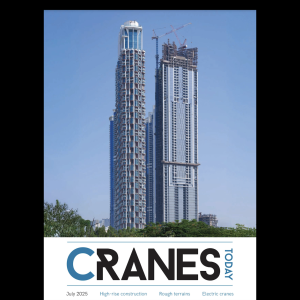The bridge needed to be positioned at the junction in Wendlingen, as part of the construction of the ICE railway line between Stuttgart and Ulm.
This job required the simultaneous use of three systems. Marco Wilhelm, project manager from Wiesbauer, explained: "We had to coordinate the Cometto SPMT, the slipway from Schachtbau Nordhausen and our 1000t crawler crane."
Apart from the 12 Cometto axle lines and two power packs from Wiesbauer's fleet, 12 MSPE units from Schares of Bocholt were also deployed. Wiesbauer coupled the SPMT combination in a 12+12 side-by-side arrangement.
"We were able to countercheck the values and push forces supplied by the customer in advance using the Cosmo planning program from Cometto. This made it possible to push the 820t steel bridge over the slipway towards the crawler crane with the right force, centimetre by centimetre and above all jerk-free," said Wilhelm.
The 52m-long steel structure covered the distance with precision on the self-propelled modular transporters. Shortly before reaching the end position, one side of the bridge was set down on a slipway. Then a kind of ram was bolted to the self-propelled vehicle and the SPMT pushed the bridge into the final position of the abutment.
Team leader Fabian Spathelf from the building contractors Gottlob Rommel of Stuttgart said: "When it came to pushing the bridge, the saying was true: slowly but surely. With the Cometto SPMT, the transport speed was set so precisely that it optimally matched the insertion of the Teflon plates in the slipway."
The man who manoeuvred the self-propelled vehicle safely was experienced heavy load professional Leonard Schmid. He said that the ability to regulate the output of the two power packs with the potentiometer on the radio remote control made it possible to implement the pushing instructions from Schachtbau Nordhausen perfectly. “It was only this that made the slow advance with the forward movement possible at all," he added.






